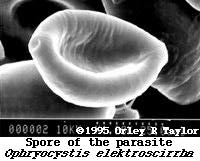
| M o n a r c h W a t c h | |
| Biology |
Anatomy
Sexing
Monarchs
Life
Cycle
Sensory
Systems
Predation
Parasite
Control
Systematics
Seasonal
Populations
Western
Population
Population
Genetics
Theories in
Evolution &
Population
Genetics
| Predation : By Invertebrates, Parasitoids and Disease | ||
Although the larval stage is where most predation and death probably occur, few researchers have investigated this area. The sections below explore the anecdotal and rare experimental evidence about the impact of invertebrate predators, parasitoids, and pathogens on larvae and adults. Invertebrate Predation Very little ecological or evolutionary research has been done regarding invertebrate predation on Monarch butterflies, and most of the literature contains merely anecdotal evidence of predation events. For example, one group of scientists report a wasp attacking an adult Monarch butterfly in an overwinter California population. The wasp, Vespula vulgaris, fed on the butterfly's abdomen. Other naturalists and scientists have observed other wasps, ambush bugs, and stink bugs killing and consuming Monarch larvae, but these predators are not well studied. In a more comprehensive research program, a researcher at Cornell University is studying the impact of different levels of cardenolides and other poisons on wasp predation and consumption of various larvae. Her preliminary results suggest that some wasps are sensitive to chemical concentrations and may selectively hunt larvae with lower concentrations of poisons. Parasitoids Researchers and naturalists have observed a small number of species that are parasitoids on Monarch butterflies. Four species of tachinid flies lay their eggs on Monarch larvae. The tachinid larva burrows into a Monarch larva and eats tissues and fluid from the monarch's body. The Monarch larva lives and continues to grow until the tachinid larva is ready to leave. Then the fly larva kills its Monarch host. Disease (Pathogens) Diseases are usually caused by organisms (called pathogens) that live inside other organisms, taking nutrients and other resources from the host. Pathogens can be fungi, bacteria, viruses, or single-celled organisms called protozoans. Can you think of organisms from each of these groups that affect humans? There has been no research on fungal infections of Monarchs, probably because none have been observed yet. This is interesting, since many Monarchs are raised in captivity for research and educational purposes. Most other species of butterflies raised in captivity are susceptible to fungal attacks. Anecdotal evidence also suggests that milkweed plants are resistant to fungi. Can you think of ways to test whether or not these two observations are related? Five bacterial pathogens have been reported for Monarchs. One of these is a psuedomonas that seems to only invade larvae already weakened by other disease. Other butterflies and moths are susceptible to bacillus bacteria, but this group of bacteria has not been observed in Monarchs.
The best-studied disease of Monarchs is the parasitic protozoan Ophryocystis elektroscirrha. The parasite develops inside the Monarch larva and pupa, and is transmitted from generation to generation by spores, which are shed from the scales of the adult female onto her eggs and the surface of milkweed plants as she lays eggs. The spores are also transferred between males and females during copulation (mating). Introduction : At Overwintering Sites : By Invertebrates, Parasitoids & Disease |
|
m o n a r c h @ k u . e d u |
 Nuclear polyhedrosis virus is probably the most important viral pathogen for Monarchs. Both larvae and pupae are vulnerable. This virus forms crystals inside infected cells, and the crystals kill the cells. The virus actually putrefies the insides of the infected individual. Infected Monarch larvae become lethargic, lose their bright yellow and white stripes, and turn light brown, then dark brown, then black. If you pick up an infected larva when it is black, it will break open and a foul-smelling black liquid will spill out. Monarch pupae infected with this virus turn from light green to yellow to black.
Nuclear polyhedrosis virus is probably the most important viral pathogen for Monarchs. Both larvae and pupae are vulnerable. This virus forms crystals inside infected cells, and the crystals kill the cells. The virus actually putrefies the insides of the infected individual. Infected Monarch larvae become lethargic, lose their bright yellow and white stripes, and turn light brown, then dark brown, then black. If you pick up an infected larva when it is black, it will break open and a foul-smelling black liquid will spill out. Monarch pupae infected with this virus turn from light green to yellow to black.
 All material on this site © Monarch Watch unless otherwise noted.
All material on this site © Monarch Watch unless otherwise noted.